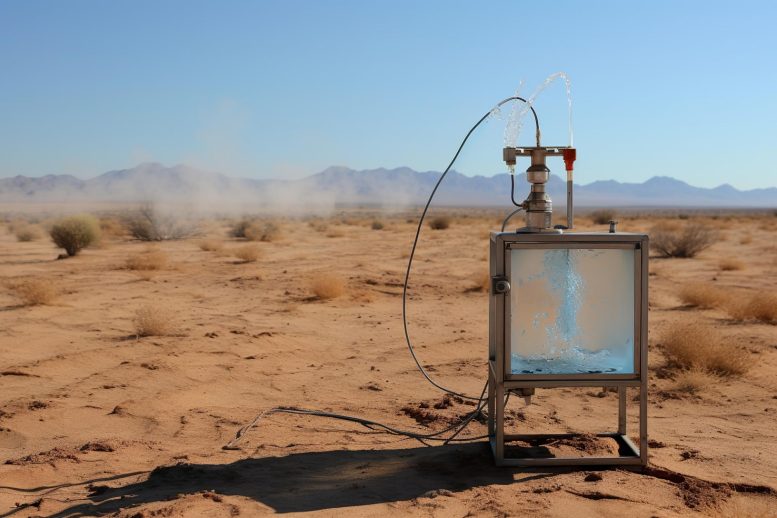
MIT engineers have synthesized a new superabsorbent hydrogel infused with lithium chloride that can absorb an unprecedented amount of moisture, even in desert-like conditions. This material has the potential for large-scale use in passive water harvesting and improving air conditioning efficiency. (Artist’s concept.)
A new material developed by MIT engineers exhibits “record-breaking” vapor absorption.
MIT engineers have synthesized a superabsorbent material that can soak up a record amount of moisture from the air, even in desert-like conditions.
As the material absorbs water vapor, it can swell to make room for more moisture. Even in very dry conditions, with 30 percent relative humidity, the material can pull vapor from the air and hold in the moisture without leaking. The water could then be heated and condensed, then collected as ultrapure water.
The transparent, rubbery material is made from hydrogel, a naturally absorbent material that is also used in disposable diapers. The team enhanced the hydrogel’s absorbency by infusing it with lithium chloride — a type of salt that is known to be a powerful dessicant.
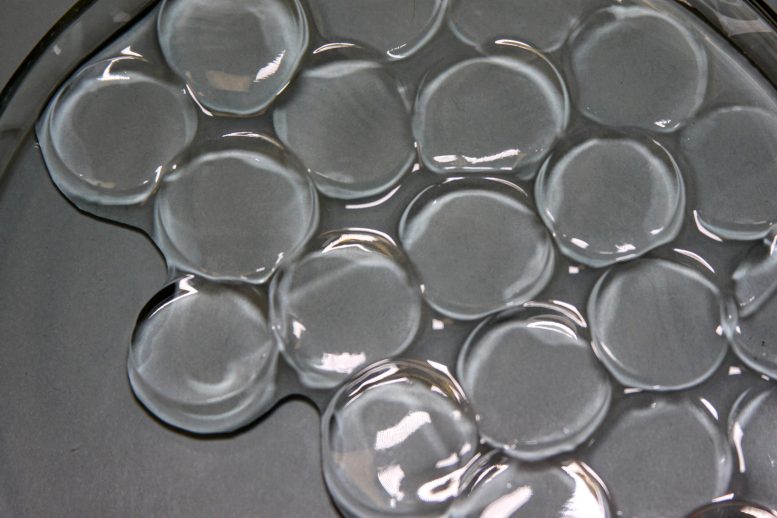
MIT engineers have synthesized a superabsorbent material that can soak up a record amount of moisture from the air, even in desert-like conditions. Pictured are the hydrogel discs swollen in water. Credit: Gustav Graeber and Carlos D. Díaz-Marín
The researchers found they could infuse the hydrogel with more salt than was possible in previous studies. As a result, they observed that the salt-loaded gel absorbed and retained an unprecedented amount of moisture, across a range of humidity levels, including very dry conditions that have limited other material designs.
If it can be made quickly, and at large scale, the superabsorbent gel could be used as a passive water harvester, particularly in the desert and drought-prone regions, where the material could continuously absorb vapor, that could then be condensed into drinking water. The researchers also envision that the material could be fit onto air conditioning units as an energy-saving, dehumidifying element.
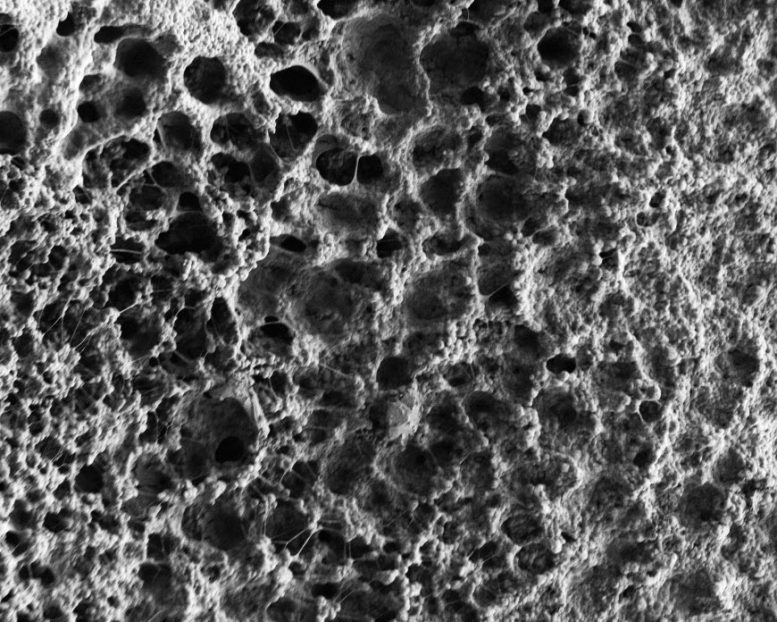
“The hydrogel can store a lot of water, and the salt can capture a lot of vapor. So it’s intuitive that you’d want to combine the two,” says Gustav Graeber. Pictured is a microscopic image of a dry, salt-loaded hydrogel. Credit: Gustav Graeber and Carlos D. Díaz-Marín
“We’ve been application-agnostic, in the sense that we mostly focus on the fundamental properties of the material,” says Carlos Díaz-Marin, a mechanical engineering graduate student and member of the Device Research Lab at MIT. “But now we are exploring widely different problems like how to make air conditioning more efficient and how you can harvest water. This material, because of its low cost and high performance, has so much potential.”
Díaz-Marin and his colleagues have published their results in a paper published recently in the journal Advanced Materials. The study’s MIT co-authors are Gustav Graeber, Leon Gaugler, Yang Zhong, Bachir El Fil, Xinyue Liu, and Evelyn Wang.
“Best of both worlds”
In MIT’s Device Research Lab, researchers are designing novel materials to solve the world’s energy and water challenges. In looking for materials that can help to harvest water from the air, the team zeroed in on hydrogels — slippery, stretchy gels that are mostly made from water and a bit of cross-linked polymer. Hydrogels have been used for years as absorbent material in diapers because they can swell and soak up a large amount of water when it comes in contact with the material.
“Our question was, how can we make this work just as well to absorb vapor from the air?” Díaz-Marin says.
He and his colleagues dug through the literature and found that others had experimented with mixing hydrogels with various salts. Certain salts, such as the rock salt used to melt ice, are very efficient at absorbing moisture, including water vapor. And the best among them is lithium chloride, a salt that is capable of absorbing over 10 times its own mass in moisture. Left in a pile on its own, lithium chloride could attract vapor from the air, though the moisture would only pool around the salt, with no means of retaining the absorbed water.
So, researchers have attempted to infuse the salt into hydrogel — producing a material that could both hold in moisture and swell to accommodate more water.
“It’s the best of both worlds,” says Graeber, who is now a principal investigator at Humboldt University in Berlin. “The hydrogel can store a lot of water, and the salt can capture a lot of vapor. So it’s intuitive that you’d want to combine the two.”
Time to load
But the MIT team found that others reached a limit to the amount of salt they could load into their gels. The best performing samples to date were hydrogels that were infused with 4 to 6 grams of salt per gram of polymer. These samples absorbed about 1.5 grams of vapor per gram of material in dry conditions of 30 percent relative humidity.
In most studies, researchers had previously synthesized samples by soaking hydrogels in salty water and waiting for the salt to infuse into the gels. Most experiments ended after 24 to 48 hours, as researchers found the process was too slow, and not very much salt ended up in the gels. When they tested the resulting material’s ability to absorb water vapor, the samples soaked up very little, as they contained little salt to absorb the moisture in the first place.
What would happen if the material synthesis was allowed to go on, say, for days, and even weeks? Could a hydrogel absorb even more salt, if given enough time? For an answer, the MIT team carried out experiments with polyacrylamide (a common hydrogel) and lithium chloride (a superabsorbent salt). After synthesizing tubes of hydrogel through standard mixing methods, the researchers sliced the tubes into thin disks and dropped each disk into a solution of lithium chloride with a different salt concentration. They took the disks out of solution each day to weigh them and determine the amount of salt that had infused into the gels, then returned them to their solutions.
In the end, they found that, indeed, given more time, hydrogels took up more salt. After soaking in salty solution for 30 days, hydrogels incorporated up to 24, versus the previous record of 6 grams of salt per gram of polymer.
The team then put various samples of the salt-laden gels through absorption tests across a range of humidity conditions. They found that the samples could swell and absorb more moisture at all humidity levels, without leaking. Most notably, the team reports that at very dry conditions of 30 percent relative humidity, the gels captured a “record-breaking” 1.79 grams of water per gram of material.
“Any desert during the night would have that low relative humidity, so conceivably, this material could generate water in the desert,” says Díaz-Marin, who is now looking for ways to speed up the material’s superabsorbent properties.
“The big, unexpected surprise was that, with such a simple approach, we were able to get the highest vapor uptake reported to date,” Graeber says. “Now, the main focus will be kinetics and how quickly we can get the material to uptake water. That will allow you to cycle this material very quickly, so that instead of recovering water once a day, you could harvest water maybe 24 times a day.”
Reference: “Extreme Water Uptake of Hygroscopic Hydrogels through Maximized Swelling-Induced Salt Loading” by Gustav Graeber, Carlos D. Díaz-Marín, Leon C. Gaugler, Yang Zhong, Bachir El Fil, Xinyue Liu and Evelyn N. Wang, 18 May 2023, Advanced Materials.
DOI: 10.1002/adma.202211783
This research was supported, in part, by the U.S. Office of Energy Efficiency and Renewable Energy and the Swiss National Science Foundation.

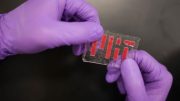
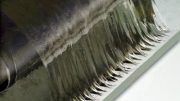
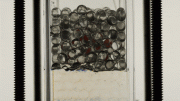
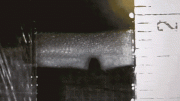
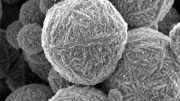

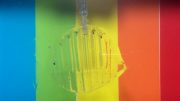
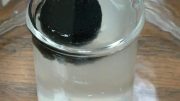
Drying out a desert? That might have serious unintended consequences. All that water is probably needed by what little life is out there.
That’s a very very bad idea the stupidest idea ever sound.lile a winner winner but it’s not u start making big scales that’s about to mess everone up bc it’s like this u take moisture out of the air that make the air dry witch will take the air hotter that means the earth will hear up and that’s when s*** start f***in up and u don’t want to heat the earth up bc there flooding there temperature change it effects the world a lot there motion air but there’s no more or no less than the earth needs I mean there’s just a right amount of moisture in the air for the climate that we live in you start hea start taking that moisture of the air air gets dry water does it heats up there goes the glaciers Antarctica there goes global weather change in the point where the Earth will Lori die basically we cook the Earth so no this water thing is a bad f****** idea they might get their head of their ass and see how the big effect it would have on everybody